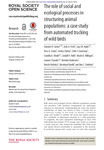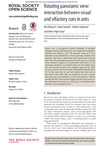Browsing Học liệu mở OER by Title
Now showing items 760-779 of 933
-
Remote sensing and conservation of isolated indigenous villages in Amazonia
(2014)The vast forests on the border between Brazil and Peru harbour a number of indigenous groups that have limited contact with the outside world. Accurate estimates of population sizes and village areas are essential to begin ... -
Repeatability in the contact calling systemof Spix’s disc winged bat
(2015)Spix’s disc-winged bat (Thyroptera tricolor) forms cohesive groups despite using an extremely ephemeral roost, partly due to the use of two acoustic signals that help individuals locate roost sites and group members. While ... -
Reproduction of Pisidium casertanum (Poli, 1791) in Arctic lake
(The Royal Society, 2015)Freshwater invertebrates are able to develop specific ecological adaptations that enable them to successfully inhabit an extreme environment. We investigated the brooding bivalve ofPisidium casertanum in Talatinskoe Lake, ... -
Reproduction of Pisidium casertanum in Arctic lake
(2015)Freshwater invertebrates are able to develop specific ecological adaptations that enable them to successfully inhabit an extreme environment. We investigated the brooding bivalve of Pisidium casertanum in Talatinskoe Lake, ... -
Research Methods in Psychology
(University of Minnesota Libraries Publishing, 2016)Chapter 1: The Science of Psychology. Chapter 2: Getting Started in Research. Chapter 3: Research Ethics. Chapter 4: Theory in Psychology. Chapter 5: Psychological Measurement. Chapter 6: Experimental Research. Chapter 7: ... -
Response to comment by Loiselle & Ramchandra
(2015)I thank Loiselle and Ramchandra (hereafter ‘the authors’) for their interest. First, I should say that it might have been a mistake to use the term ‘false discovery rate’. This is so because the same term is used in the ... -
Responsiveness to conspecific distress calls is influenced by day roost proximity in bats
(2016)Distress calls signal extreme physical distress, e.g. being caught by a predator. In many bat species, distress calls attract conspecifics. Because bats often occupy perennial day-roosts, they might adapt their responsiveness ... -
Restricted grouper reproductive migrations support community based management
(2016)Conservation commonly requires trade-offs between social and ecological goals. For tropical small-scale fisheries, spatial scales of socially appropriate management are generally small the median no-take locally managed ... -
Resumption of traditional drive hunting of dolphins in the Solomon Islands in 2013
(2015)The ‘drive hunting’ of dolphins has a long history in the Solomon Islands, specifically at the island of Malaita. In 2010, the most active village, Fanalei, suspended hunting in exchange for financial compensation from an ... -
Rethinking competence inmarine life cycles
(2015)Complex life cycles have evolved independently numerous times in marine animals as well as in disparate algae. Such life histories typically involve a dispersive immature stage followed by settlement and metamorphosis to ... -
Revision of the Late Jurassic teleosaurid genus Machimosaurus
(2014)Machimosaurus was a large-bodied genus of teleosaurid crocodylomorph, considered to have been durophagous/ chelonivorous, and which frequented coastal marine/estuarine ecosystems during the Late Jurassic. Here, we revise ... -
Rhenium uptake and distribution in phaeophyceae macroalgae, Fucus vesiculosus
(2016)Owing to Rhenium (Re) having no known biological role, it is not fully understood how Re is concentrated in oil kerogens. A commonly held assumption is that Re is incorporated into decomposing biomass under reducing ... -
Risk Management for Enterprises and Individuals
(The Saylor Foundation, 2009)Chapter 1: The Nature of Risk: Losses and Opportunities. Chapter 2: Risk Measurement and Metrics. Chapter 3: Risk Attitudes: Expected Utility Theory and Demand for Hedging. Chapter 4: Evolving Risk Management: Fundamental ... -
Rival assessment among northern elephant seals
(The Royal Society, 2015)Specialized signals emitted by competing males often convey honest information about fighting ability. It is generally believed that receivers use these signals to directly assess their opponents. Here, we demonstrate an ... -
River temperature drives salmon survivorship
(2015)Early life is believed to be a critical stage for determining survivorship in all fish. Many studies have suggested that environmental conditions in the ocean determine the fry-to-adult survival rate of Pacific salmon but ... -
RNA directed epigenetic silencing of Periostin inhibits cell motility
(2015)The over-expression of Periostin, a member of the fasciclin family of proteins, has been reported in a number of cancers and, in particular, in metastatic tumours. These include breast, ovarian, lung, colon, head and neck, ... -
The role of sarcomere length non-uniformities in residual force enhancement of skeletal musclemyofibrils
(2016)The sarcomere length non-uniformity theory (SLNT) is a widely accepted explanation for residual force enhancement (RFE). RFE is the increase in steady-state isometric force following active muscle stretching. The SLNT ... -
The role of social and ecological processes in structuring animal populations
(2015)Both social and ecological factors influence population process and structure, with resultant consequences for phenotypic selection on individuals. Understanding the scale and relative contribution of these two factors is ... -
Role reversal in a predator–prey interaction
(2014)Predator–prey relationships are one of the most studied interactions in population ecology. However, little attention has been paid to the possibility of role exchange between species, despite firm field evidence of such ... -
Rotating panoramic view
(2016)Insects use a navigational toolkit consisting of multiple strategies such as path integration, view-dependent recognition methods and olfactory cues. The question arises as to how directional cues afforded by a visual ...




















